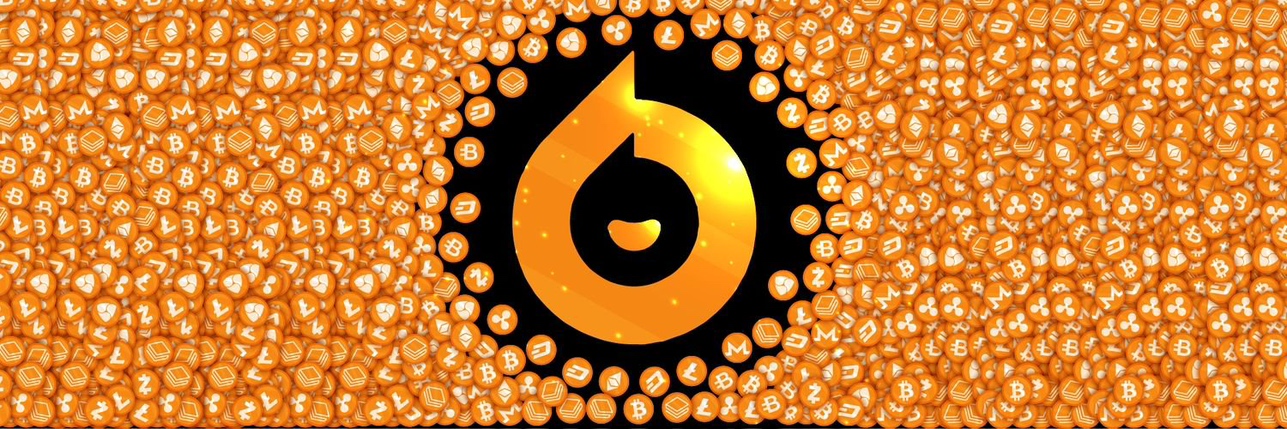Bitget: Ranked top 4 in global daily trading volume!
BTC dominance63.40%
New listings: Pi Network
Hot BTC ETF : IBIT
BTC/USDT$94629.45 (+2.18%)Fear and Greed Index60(Greed)
Altcoin season index:0(Bitcoin season)
Coins listed in Pre-MarketINITTotal spot Bitcoin ETF netflow +$442M (1D); +$2.59B (7D).Welcome gift package for new users worth 6200 USDT.Claim now
Trade anytime, anywhere with the Bitget app. Download now
Bitget: Ranked top 4 in global daily trading volume!
BTC dominance63.40%
New listings: Pi Network
Hot BTC ETF : IBIT
BTC/USDT$94629.45 (+2.18%)Fear and Greed Index60(Greed)
Altcoin season index:0(Bitcoin season)
Coins listed in Pre-MarketINITTotal spot Bitcoin ETF netflow +$442M (1D); +$2.59B (7D).Welcome gift package for new users worth 6200 USDT.Claim now
Trade anytime, anywhere with the Bitget app. Download now
Bitget: Ranked top 4 in global daily trading volume!
BTC dominance63.40%
New listings: Pi Network
Hot BTC ETF : IBIT
BTC/USDT$94629.45 (+2.18%)Fear and Greed Index60(Greed)
Altcoin season index:0(Bitcoin season)
Coins listed in Pre-MarketINITTotal spot Bitcoin ETF netflow +$442M (1D); +$2.59B (7D).Welcome gift package for new users worth 6200 USDT.Claim now
Trade anytime, anywhere with the Bitget app. Download now



Virtuals Protocol PriceVIRTUAL
Listed
Quote currency:
USD
The VIRTUALUSDT spot trading pair and futures trading pair had been launched. VIRTUAL trading bots has aslo be available.
$0.9129+31.75%1D
VIRTUAL to USD converter
VIRTUAL
USD
1 VIRTUAL = 0.00 USD
Bitget offers the lowest transaction fees among all major trading platforms. The higher your VIP level, the more favorable the rates.
Price Chart
TradingView
Market cap
Virtuals Protocol price chart (VIRTUAL/USD)
Last updated as of 2025-04-25 12:51:51(UTC+0)
Market cap:$594,596,166.75
Fully diluted market cap:$594,596,166.75
Volume (24h):$219,906,698.23
24h volume / market cap:36.98%
24h high:$0.9177
24h low:$0.6927
All-time high:$5.07
All-time low:$0.007608
Circulating supply:651,299,600 VIRTUAL
Total supply:
1,000,000,000VIRTUAL
Circulation rate:65.00%
Max supply:
1,000,000,000VIRTUAL
Price in BTC:0.{5}9624 BTC
Price in ETH:0.0005100 ETH
Contracts:
0x0b3e...24e7E1b(Base)
More
How do you feel about Virtuals Protocol today?
Note: This information is for reference only.
About Virtuals Protocol (VIRTUAL)
What Is Virtuals Protocol?
Virtuals Protocol is an AI and Metaverse Protocol launched in 2024. It is designed to revolutionize virtual interactions by creating hyper-personalized and immersive experiences. Virtuals Protocol focuses on integrating advanced AI agents into various digital environments such as gaming, metaverses, and online interactions. The protocol leverages decentralization to foster creativity, diversity, and trust, ensuring that virtual engagements are not only innovative but also equitable for all participants involved.
The transition to virtual spaces is inevitable, and Virtuals Protocol aims to lead this transformation by making virtual interactions more engaging and lifelike. By utilizing generative AI and multimodal outputs (text, sound, visuals), Virtuals Protocol enhances personalization and immersion, making every virtual experience a unique journey. This approach not only enriches user experiences but also creates new economic opportunities for developers, creators, and users within the ecosystem.
Resources
Official Documents:
https://whitepaper.virtuals.io/
Official Website:
https://www.virtuals.io/
How Does Virtuals Protocol Work?
Virtuals Protocol operates through a decentralized ecosystem that incentivizes the creation and use of AI agents, known as VIRTUALs. These agents can perform complex, multimodal interactions, thanks to their integration of various specialized cores, including the Cognitive Core, Voice and Sound Core, and Visual Core. This structure allows VIRTUALs to behave like characters from intellectual properties, perform specific tasks, or even act as digital versions of individuals, enhancing both entertainment and utility in virtual spaces.
The ecosystem is built on two main layers: the Protocol Layer and the DApp Layer. The Protocol Layer serves as a model hub, providing foundational AI models and algorithms that developers can access and build upon. Contributors provide data and develop models, while validators ensure the quality and authenticity of these inputs. The DApp Layer, on the other hand, focuses on the practical application of these AI models, allowing decentralized applications (DApps) to integrate VIRTUALs seamlessly. This integration is facilitated by a developer-friendly Software Development Kit (SDK), which simplifies the process of incorporating advanced AI features into various DApp environments.
Economic incentives play a crucial role in sustaining the Virtuals Protocol ecosystem. Contributors and validators are rewarded with VIRTUAL tokens for their efforts, ensuring a continuous influx of high-quality data and models. The protocol also employs a buyback scheme where revenue generated from DApps is used to repurchase VIRTUAL tokens, maintaining the token's value and stability. This self-sustaining cycle, known as the Virtual-ous Flywheel, ensures that the ecosystem remains vibrant and productive.
What Is VIRTUAL Token?
VIRTUAL is the utility and governance token of the Virtuals Protocol ecosystem. It serves multiple functions, including incentivizing contributions, supporting development decisions, and managing the protocol’s treasury. Token holders can stake their VIRTUAL tokens to influence which AI agents receive development support, ensuring that resource allocation aligns with community interests.
VIRTUAL tokens also facilitate a buyback scheme, where a portion of the revenue generated from DApps is used to repurchase tokens from the open market. This mechanism helps maintain the token’s value and supports the protocol’s long-term sustainability. Additionally, VIRTUAL token holders benefit from airdrops related to new token offerings within the ecosystem, further encouraging long-term engagement and participation. VIRTUAL has a total supply of 1 billion tokens.
What Determines Virtuals Protocol’s Price?
The price of Virtuals Protocol (VIRTUAL) is influenced by a combination of supply and demand dynamics, market sentiment, and the latest news in the blockchain and Web3 space. Factors such as increased adoption of Virtuals Protocol in decentralized applications (DApps), positive cryptocurrency trends, and strategic partnerships can drive demand and subsequently boost the token's value. Conversely, market volatility, changes in cryptocurrency regulation, and overall sentiment in the cryptocurrency market can impact the price. Keeping an eye on VIRTUAL cryptocurrency charts and performing regular
cryptocurrency analysis can provide insights into potential price movements.
In addition to these factors, cryptocurrency price prediction models and expert analysis can help investors gauge the future performance of the VIRTUAL token. The token's price is also affected by the protocol's tokenomics, including the buyback scheme and token distribution strategies. As the ecosystem grows and more DApps utilize VIRTUALs, the token's value may increase, making it potentially the best crypto investment for 2024 and beyond. However, investors should be mindful of cryptocurrency risks and market volatility, ensuring they stay informed about the latest developments and trends within the Virtuals Protocol ecosystem.
For those interested in investing or trading Virtuals Protocol, one might wonder: Where to buy VIRTUAL? You can purchase VIRTUAL on leading exchanges, such as Bitget, which offers a secure and user-friendly platform for cryptocurrency enthusiasts.
AI analysis report on Virtuals Protocol
Today's crypto market highlightsView report
Today's Virtuals Protocol price performance summaryView report
Virtuals Protocol project analysis reportView report
Live Virtuals Protocol Price Today in USD
The live Virtuals Protocol price today is $0.9129 USD, with a current market cap of $594.60M. The Virtuals Protocol price is up by 31.75% in the last 24 hours, and the 24-hour trading volume is $219.91M. The VIRTUAL/USD (Virtuals Protocol to USD) conversion rate is updated in real time.
Virtuals Protocol Price History (USD)
The price of Virtuals Protocol is +485.46% over the last year. The highest price of VIRTUAL in USD in the last year was $5.07 and the lowest price of VIRTUAL in USD in the last year was $0.02019.
TimePrice change (%) Lowest price
Lowest price Highest price
Highest price 
 Lowest price
Lowest price Highest price
Highest price 
24h+31.75%$0.6927$0.9177
7d+59.58%$0.5516$0.9177
30d+13.08%$0.4249$0.9177
90d-64.14%$0.4249$2.52
1y+485.46%$0.02019$5.07
All-time+812.36%$0.007608(2024-01-23, 1 years ago )$5.07(2025-01-02, 113 days ago )
What is the highest price of Virtuals Protocol?
The all-time high (ATH) price of Virtuals Protocol in USD was $5.07, recorded on 2025-01-02. Compared to the Virtuals Protocol ATH, the current price of Virtuals Protocol is down by 82.00%.
What is the lowest price of Virtuals Protocol?
The all-time low (ATL) price of Virtuals Protocol in USD was $0.007608, recorded on 2024-01-23. Compared to the Virtuals Protocol ATL, the current price of Virtuals Protocol is up by 11899.27%.
Virtuals Protocol Price Prediction
What will the price of VIRTUAL be in 2026?
Based on VIRTUAL's historical price performance prediction model, the price of VIRTUAL is projected to reach $1.13 in 2026.
What will the price of VIRTUAL be in 2031?
In 2031, the VIRTUAL price is expected to change by +19.00%. By the end of 2031, the VIRTUAL price is projected to reach $2.24, with a cumulative ROI of +190.83%.
FAQ
What factors influence the price of Virtuals Protocol?
The price of Virtuals Protocol is influenced by various factors including market demand and supply, technological advancements, regulatory news, partnerships, and the overall performance of the cryptocurrency market.
How can I buy Virtuals Protocol on Bitget Exchange?
To buy Virtuals Protocol on Bitget Exchange, you need to create an account, verify your identity, deposit funds, and then you can search for the Virtuals Protocol trading pair to make a purchase.
What is the future price prediction for Virtuals Protocol?
It's challenging to provide an exact price prediction for Virtuals Protocol due to market volatility, but analysts often look at factors like project development, market trends, and adoption rates for potential future growth.
Why is Virtuals Protocol's price so volatile?
The price of Virtuals Protocol is volatile because the cryptocurrency market is still relatively new, with lower liquidity compared to traditional markets, and it's influenced by speculative trading and market sentiment.
Can the price of Virtuals Protocol reach $100?
While reaching $100 is possible, it would depend on significant increases in demand, adoption, partnerships, and broader market conditions which could take time to develop.
How does staking Virtuals Protocol affect its price?
Staking Virtuals Protocol can reduce the supply available on exchanges, potentially increasing the price if demand remains steady or increases. It also encourages holding, reducing sell pressure.
What are the risks of investing in Virtuals Protocol?
Risks include high market volatility, regulatory changes, potential security vulnerabilities, and competition from other blockchain projects. Investors should do thorough research before investing.
How often does the price of Virtuals Protocol change?
The price of Virtuals Protocol can change every few seconds on trading platforms like Bitget Exchange, as it's determined by real-time market supply and demand.
Is Virtuals Protocol a good investment?
Whether Virtuals Protocol is a good investment depends on individual risk tolerance, investment goals, and market analysis. It's important to research and consider trends, use case, and the team behind the project.
What should I check before buying Virtuals Protocol?
Before buying Virtuals Protocol, check its market position, latest news, development updates, trading volume on Bitget Exchange, and community engagement to make an informed decision.
What is the current price of Virtuals Protocol?
The live price of Virtuals Protocol is $0.91 per (VIRTUAL/USD) with a current market cap of $594,596,166.75 USD. Virtuals Protocol's value undergoes frequent fluctuations due to the continuous 24/7 activity in the crypto market. Virtuals Protocol's current price in real-time and its historical data is available on Bitget.
What is the 24 hour trading volume of Virtuals Protocol?
Over the last 24 hours, the trading volume of Virtuals Protocol is $219.91M.
What is the all-time high of Virtuals Protocol?
The all-time high of Virtuals Protocol is $5.07. This all-time high is highest price for Virtuals Protocol since it was launched.
Can I buy Virtuals Protocol on Bitget?
Yes, Virtuals Protocol is currently available on Bitget’s centralized exchange. For more detailed instructions, check out our helpful How to buy virtual-protocol guide.
Can I get a steady income from investing in Virtuals Protocol?
Of course, Bitget provides a strategic trading platform, with intelligent trading bots to automate your trades and earn profits.
Where can I buy Virtuals Protocol with the lowest fee?
Bitget offers industry-leading trading fees and depth to ensure profitable investments for traders. You can trade on the Bitget exchange.
Virtuals Protocol news
VIRTUAL, IP, and ONDO among Binance’s 2nd batch of Vote to List Campaign
Coinjournal•2025-04-02 15:44
See more
Virtuals Protocol updates
Virtuals Protocol Market
Virtuals Protocol Holdings
Virtuals Protocol holdings distribution matrix
Virtuals Protocol holdings by concentration
Whales
Investors
Retail
Virtuals Protocol addresses by time held
Holders
Cruisers
Traders
Live coinInfo.name (12) price chart

Global Virtuals Protocol Prices
How much is Virtuals Protocol worth right now in other currencies? Last updated: 2025-04-25 12:51:51(UTC+0)
VIRTUAL to MXN
Mexican Peso
Mex$17.93VIRTUAL to GTQGuatemalan Quetzal
Q7.03VIRTUAL to CLPChilean Peso
CLP$854.53VIRTUAL to UGXUgandan Shilling
Sh3,344.98VIRTUAL to HNLHonduran Lempira
L23.66VIRTUAL to ZARSouth African Rand
R17.19VIRTUAL to TNDTunisian Dinar
د.ت2.73VIRTUAL to IQDIraqi Dinar
ع.د1,195.36VIRTUAL to TWDNew Taiwan Dollar
NT$29.69VIRTUAL to RSDSerbian Dinar
дин.94.22VIRTUAL to DOPDominican Peso
RD$54.2VIRTUAL to MYRMalaysian Ringgit
RM3.99VIRTUAL to GELGeorgian Lari
₾2.5VIRTUAL to UYUUruguayan Peso
$38.09VIRTUAL to MADMoroccan Dirham
د.م.8.46VIRTUAL to OMROmani Rial
ر.ع.0.35VIRTUAL to AZNAzerbaijani Manat
₼1.55VIRTUAL to KESKenyan Shilling
Sh118.18VIRTUAL to SEKSwedish Krona
kr8.84VIRTUAL to UAHUkrainian Hryvnia
₴38.16- 1
- 2
- 3
- 4
- 5
How to buy Virtuals Protocol(VIRTUAL)

Create Your Free Bitget Account
Sign up on Bitget with your email address/mobile phone number and create a strong password to secure your account.

Verify Your Account
Verify your identity by entering your personal information and uploading a valid photo ID.

Convert Virtuals Protocol to VIRTUAL
Choose from cryptocurrencies to trade on Bitget.
Learn moreTrade VIRTUAL perpetual futures
After having successfully signed up on Bitget and purchased USDT or VIRTUAL tokens, you can start trading derivatives, including VIRTUAL futures and margin trading to increase your income.
The current price of VIRTUAL is $0.9129, with a 24h price change of +31.75%. Traders can profit by either going long or short onVIRTUAL futures.
Join VIRTUAL copy trading by following elite traders.
After signing up on Bitget and successfully buying USDT or VIRTUAL tokens, you can also start copy trading by following elite traders.
New listings on Bitget
New listings
Buy more
Where can I buy Virtuals Protocol (VIRTUAL)?
Buy crypto on the Bitget app
Sign up within minutes to purchase crypto via credit card or bank transfer.
Video section — quick verification, quick trading

How to complete identity verification on Bitget and protect yourself from fraud
1. Log in to your Bitget account.
2. If you're new to Bitget, watch our tutorial on how to create an account.
3. Hover over your profile icon, click on “Unverified”, and hit “Verify”.
4. Choose your issuing country or region and ID type, and follow the instructions.
5. Select “Mobile Verification” or “PC” based on your preference.
6. Enter your details, submit a copy of your ID, and take a selfie.
7. Submit your application, and voila, you've completed identity verification!
Cryptocurrency investments, including buying Virtuals Protocol online via Bitget, are subject to market risk. Bitget provides easy and convenient ways for you to buy Virtuals Protocol, and we try our best to fully inform our users about each cryptocurrency we offer on the exchange. However, we are not responsible for the results that may arise from your Virtuals Protocol purchase. This page and any information included are not an endorsement of any particular cryptocurrency. Any price and other information on this page is collected from the public internet and can not be consider as an offer from Bitget.
VIRTUAL to USD converter
VIRTUAL
USD
1 VIRTUAL = 0.9129 USD
Bitget offers the lowest transaction fees among all major trading platforms. The higher your VIP level, the more favorable the rates.
Virtuals Protocol ratings
Average ratings from the community
4.6
This content is for informational purposes only.
Bitget Insights
tswaryianve
8h
INIT coin is associated with Inite, an AI-driven human innovation network that leverages Web3 technologies. Here's what it's all about¹:
- *Purpose*: Inite aims to foster creative idea generation, organize and engage people, automate the innovation process, and manage and pay for copyrights.
- *Key Features*:
- *Idea Management Solution*: A decentralized platform for sharing and discovering ideas, integrated with an AI assistant.
- *Collaboration Tools*: AI-driven team matching, shared virtual workspaces, and project management tools.
- *Monetization*: Includes features like tokenized ownership, profit-sharing, and support for fundraising.
- *Technology*: Inite utilizes Zero-Knowledge Machine Learning and Fully Homomorphic Encryption (FHE) to enable confidential collaboration on projects using machine learning without disclosing private information.
- *Market*: The platform is positioned to capitalize on the rapidly growing autonomous intelligent agents market, targeting early adopters in the Web3 community and B2B sales in the real economy.
- *Current Status*: INIT tokens are not yet available for trade on major exchanges listed on CoinGecko, but users can stay updated on INIT's price movements by adding it to their watchlist.
In terms of market performance, INIT coin has shown some activity:
- *Current Price*: $0.6935
- *Market Cap*: $103,216,955
- *24-hour Trading Volume*: $527,417,100
- *Circulating Supply*: 148,750,000
- *Total Supply*: 1,000,000,000²
FHE+1.30%
VIRTUAL+15.41%

Bpay-News
9h
AI Coin 24-Hour Mindshare Ranking: FARTCOIN, VIRTUAL, Openledger Take Top Three
FARTCOIN-4.37%
VIRTUAL+15.41%

rukeey
17h
What is NFT How does work it
An NFT, or Non-Fungible Token, is a unique digital asset that represents ownership or proof of authenticity of a specific item or piece of content, typically utilizing blockchain technology. Unlike cryptocurrencies like Bitcoin or Ethereum, which are fungible (one unit is interchangeable with another), NFTs are non-fungible, meaning each one is distinct and cannot be replaced with something else.
### How NFTs Work
1. **Blockchain Technology**:
- NFTs are primarily built on blockchain networks, with Ethereum being the most popular. A blockchain is a decentralized ledger that records all transactions across a network of computers.
2. **Smart Contracts**:
- NFTs are created through smart contracts, which are self-executing contracts with the terms of the agreement directly written into code. These contracts outline the ownership and transfer details of the NFT.
3. **Token Standards**:
- Most NFTs conform to specific token standards that define their properties and capabilities. The most common standards are ERC-721 and ERC-1155 for Ethereum-based NFTs.
4. **Metadata**:
- Each NFT contains metadata that describes its attributes and provenance (history of ownership). This can include images, audio, videos, and other forms of digital content.
5. **Ownership**:
- Ownership of an NFT is recorded on the blockchain. When someone purchases an NFT, the transaction is permanently recorded, and the buyer receives a unique token that signifies their ownership.
6. **Buying and Selling**:
- NFTs are typically bought and sold on various online marketplaces that specialize in digital assets, such as OpenSea, Rarible, and Foundation. Transactions often involve cryptocurrency.
7. **Provenance and Scarcity**:
- The unique nature of NFTs ensures that each one is provably scarce. Artists and creators can issue limited editions, and buyers can verify the authenticity and history of ownership for each token.
### Uses of NFTs
NFTs can represent a wide range of assets, including:
- **Digital Art**: Artists can sell their artwork as NFTs, providing a new revenue stream while maintaining ownership rights.
- **Collectibles**: Digital trading cards, virtual pets, and other virtual collectibles are popular forms of NFTs.
- **Music and Video**: Musicians and filmmakers can sell their work directly to fans as NFTs.
- **Virtual Real Estate**: In virtual worlds (like Decentraland or The Sandbox), land and properties can be represented as NFTs.
- **Gaming**: In-game assets, characters, and skins can be tokenized, giving players true ownership over their items.
### Conclusion
NFTs have opened new avenues for creators and collectors, enabling ownership of digital assets in a way that was not possible before. However, the NFT market is also subject to volatility, speculation, and various legal considerations, making it important for participants to do their research and understand the risks involved.$BGB
BGB+0.76%
VIRTUAL+15.41%

Cryptonews Official
18h
Sui launches virtual Mastercard with xPortal and xMoney in Europe
Sui is partnering with xMoney and xPortal to launch a virtual Mastercard for European users, allowing them to spend crypto like cash.
Sui is expanding into everyday payments through a new partnership with financial platform xMoney and crypto super-app xPortal. Together, they are launching a virtual Mastercard that allows European users to spend crypto like cash.
The partnership introduces a full-stack payment solution: a custom Sui ( SUI ) wallet experience integrated into xPortal’s app, already used by 2.5 million people.
This includes a branded virtual Mastercard that users can add to Apple Pay or Google Pay and use across over 20,000 merchants.
A physical card is expected later in 2025, according to a company note shared with crypto.news.
“This powerful new product is a significant step towards making the Sui ecosystem more accessible to everyday consumers,” said Christian Thompson, Managing Director of the Sui Foundation.
By leveraging xPortal’s user-friendly interface and xMoney’s licensed infrastructure, the offering combines self-custody with seamless spending.
It positions Sui among the few Layer 1 blockchains enabling real-world payments in a compliant way, starting in the EU.
Sergiu Biris, CEO of xPortal, emphasized Sui’s performance and community as key reasons for the integration, while Greg Siourounis of xMoney highlighted the platform’s goal of bridging crypto with traditional finance.
The company plans to expand in the U.S. and introduce more enterprise services, which will be announced at the upcoming Sui Basecamp event.
PEOPLE+0.40%
SUPER+6.22%

ynlgraphicx
18h
THE OPPORTUNITIES IN WEB3 THAT DOESN'T COUNT IN WEB2
1. Decentralized Finance (DeFi)
Build or invest in decentralized applications (dApps) that offer lending, borrowing, staking, or trading without intermediaries.
Create smart contracts for custom financial tools or protocols.
2. NFTs and Digital Ownership
Artists, creators, and brands can monetize their work through NFTs with built-in royalties.
Use NFTs for access passes, memberships, or virtual real estate.
3. Decentralized Autonomous Organizations (DAOs)
Launch or participate in DAOs for community-led decision-making.
Offer governance tokens to align incentives and raise funds.
4. Gaming and the Metaverse
Create play-to-earn games or in-game assets with real-world value.
Develop interoperable virtual experiences or economies.
5. Identity and Data Ownership
Build platforms that give users control over their identity and personal data using blockchain.
Enable secure, permissioned data sharing between users and apps.
6. Infrastructure and Development Tools
Build tools for blockchain scalability, interoperability, or usability (e.g., Layer 2 solutions, wallets, APIs).
Offer B2B services for companies looking to adopt Web3.
7. Content Creation and Social Media
Monetize content with token-based economies.
Use blockchain to verify authenticity and reward engagement directly from fans
VIRTUAL+15.41%
GAME+18.60%
Related assets
Popular cryptocurrencies
A selection of the top 8 cryptocurrencies by market cap.
Recently added
The most recently added cryptocurrencies.
Comparable market cap
Among all Bitget assets, these 8 are the closest to Virtuals Protocol in market cap.
Additional info on Virtuals Protocol
Coin-related
Trade-related
Trade
Earn
VIRTUAL is available for trading on the Bitget Exchange, and can be held in custody on Bitget wallet. Bitget Exchange is also one of the first CEX platforms to support VIRTUAL trades.
You can trade VIRTUAL on Bitget.VIRTUAL/USDT
SpotVIRTUAL/USDT
MarginVIRTUAL/USDT
USDT-M Futures
































